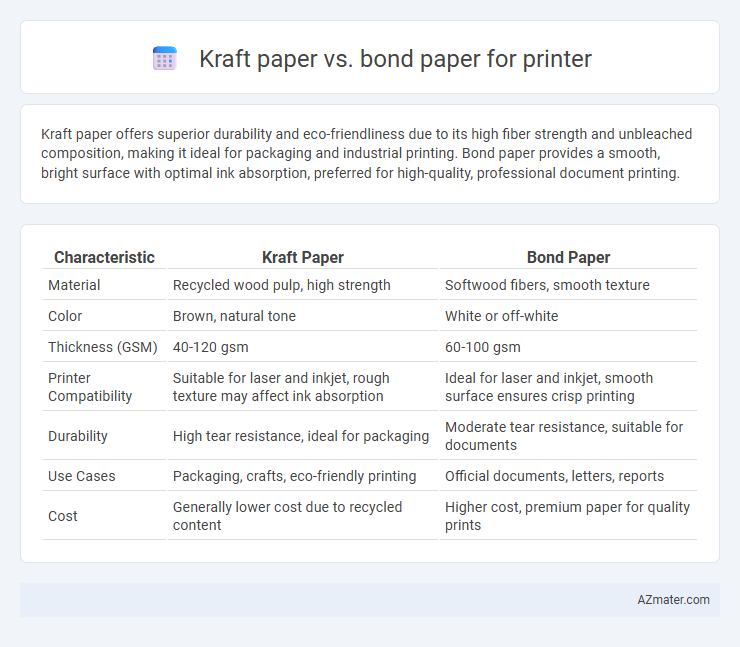Kraft paper offers superior durability and eco-friendliness due to its high fiber strength and unbleached composition, making it ideal for packaging and industrial printing. Bond paper provides a smooth, bright surface with optimal ink absorption, preferred for high-quality, professional document printing.
Table of Comparison
| Characteristic | Kraft Paper | Bond Paper |
|---|---|---|
| Material | Recycled wood pulp, high strength | Softwood fibers, smooth texture |
| Color | Brown, natural tone | White or off-white |
| Thickness (GSM) | 40-120 gsm | 60-100 gsm |
| Printer Compatibility | Suitable for laser and inkjet, rough texture may affect ink absorption | Ideal for laser and inkjet, smooth surface ensures crisp printing |
| Durability | High tear resistance, ideal for packaging | Moderate tear resistance, suitable for documents |
| Use Cases | Packaging, crafts, eco-friendly printing | Official documents, letters, reports |
| Cost | Generally lower cost due to recycled content | Higher cost, premium paper for quality prints |
Introduction to Kraft and Bond Paper
Kraft paper is a strong, coarse paper made from wood pulp, known for its durability and natural brown color, commonly used in packaging and printing for its high tear resistance. Bond paper, typically made from cotton or wood pulp, features a smooth surface and bright white color, making it ideal for high-quality printing, letterheads, and official documents. Choosing between Kraft and Bond paper depends on printer compatibility, desired texture, and the professional appearance required for the final printed product.
Key Differences Between Kraft and Bond Paper
Kraft paper is thicker and more durable, made from wood pulp using the kraft process, offering high tear resistance and a coarse texture ideal for packaging and heavy-duty printing. Bond paper is smoother, lighter, and designed for standard office printing, known for its high brightness, uniform texture, and excellent ink absorption, making it suitable for documents and professional documents. Key differences include weight, durability, texture, and typical use, with kraft paper favored for strength and eco-friendliness, while bond paper is preferred for clarity and print quality in office settings.
Physical Characteristics and Appearance
Kraft paper is characterized by its coarse texture, high durability, and natural brown color, making it ideal for heavy-duty printing and packaging tasks where strength is essential. Bond paper, in contrast, features a smoother surface, bright white color, and lighter weight, providing excellent print clarity for documents and professional presentations. While Kraft paper offers superior tear resistance, bond paper ensures crisp, sharp text and images, favoring different printing needs based on appearance and physical properties.
Printer Compatibility: Kraft vs Bond Paper
Kraft paper is thicker and coarser, which can challenge ink absorption and may cause jams in standard home or office printers, making it less compatible for everyday printing tasks. Bond paper, designed for printing, offers smooth texture and optimal thickness, ensuring better ink adhesion and consistent feed through most inkjet and laser printers. Selecting bond paper enhances print quality and reduces mechanical issues, making it the preferred choice for standard printer compatibility.
Print Quality and Color Performance
Kraft paper offers a textured surface that absorbs ink more readily, resulting in muted print quality and limited color vibrancy, which is less ideal for detailed or colorful prints. Bond paper features a smooth, tightly woven surface that enhances ink adhesion, delivering sharper print quality and more accurate color reproduction suitable for professional documents. Choosing bond paper improves printer output clarity and color depth, while kraft paper is better suited for rustic or utilitarian prints where color intensity is not critical.
Durability and Strength Comparison
Kraft paper exhibits superior durability and tensile strength due to its unbleached fibers and dense composition, making it ideal for heavy-duty printing tasks and packaging materials. Bond paper, while smoother and better suited for high-quality text and image printing, generally offers less resistance to tearing and wear compared to kraft paper. For applications requiring robustness and longevity, kraft paper outperforms bond paper in maintaining structural integrity under stress.
Eco-Friendliness and Sustainability
Kraft paper, known for its unbleached, natural fibers, offers superior eco-friendliness due to its biodegradable and recyclable properties, making it a sustainable choice for printing projects. Bond paper typically undergoes chemical bleaching and contains additives, which can reduce its environmental benefits despite its widespread use in offices. Choosing kraft paper supports sustainable practices by minimizing chemical waste and promoting the use of renewable raw materials in printing applications.
Common Applications in Printing
Kraft paper is commonly used for packaging, labels, and eco-friendly printing projects due to its durability and natural brown color, making it ideal for rustic or vintage designs. Bond paper, favored in offices and schools, is widely used for everyday printing tasks such as documents, letters, and flyers because of its smooth texture and high brightness. Both papers serve distinct purposes, with kraft paper excelling in heavy-duty and artistic prints, while bond paper delivers crisp, professional-quality prints for standard text and graphics.
Cost Considerations and Budget Impact
Kraft paper offers a lower cost per sheet compared to bond paper, making it a budget-friendly choice for high-volume printing tasks. Its durability and thickness can reduce waste and reprints, further optimizing overall expenses. Bond paper, while more expensive, provides a smoother surface ideal for professional documents, potentially justifying the higher cost in quality-critical projects.
Choosing the Best Paper for Your Printing Needs
Kraft paper offers robust durability and a natural, rustic aesthetic, making it ideal for packaging, crafts, and eco-friendly printing projects, while bond paper excels in producing sharp, clean text and images, suitable for everyday office printing and formal documents. Choosing the best paper depends on whether durability and texture or print clarity and professionalism are your priorities. For high-quality text prints and smooth finishes, bond paper is preferable, whereas kraft paper is better for projects requiring thicker, more textured material.

Infographic: Kraft paper vs Bond paper for Printer
 azmater.com
azmater.com